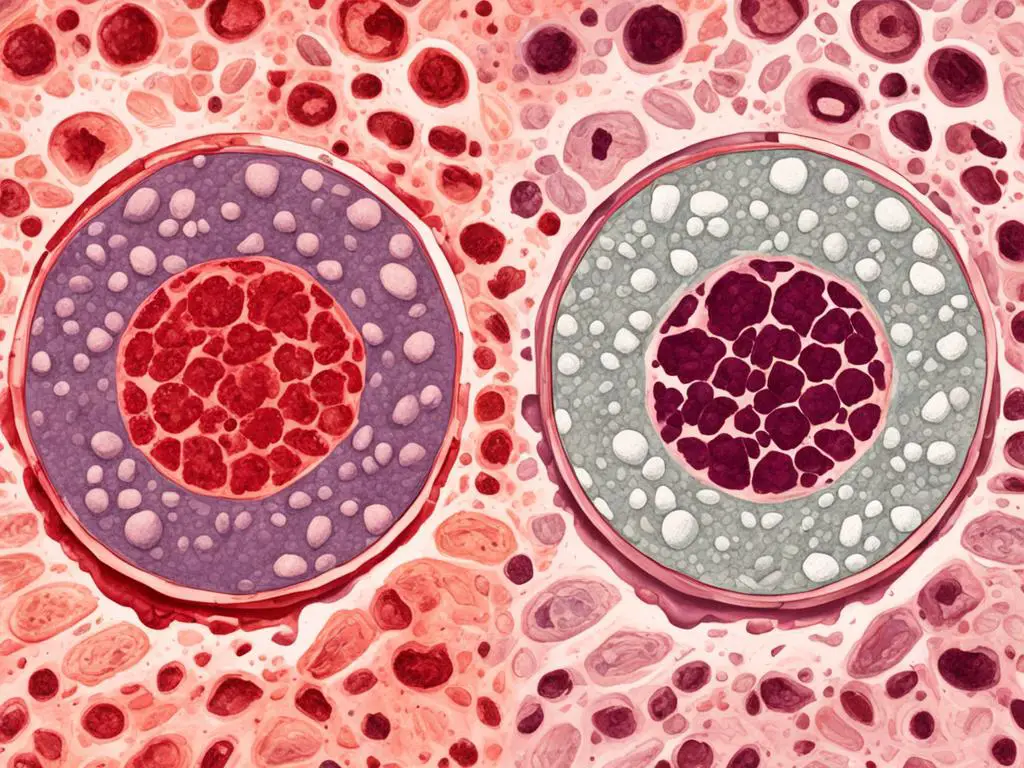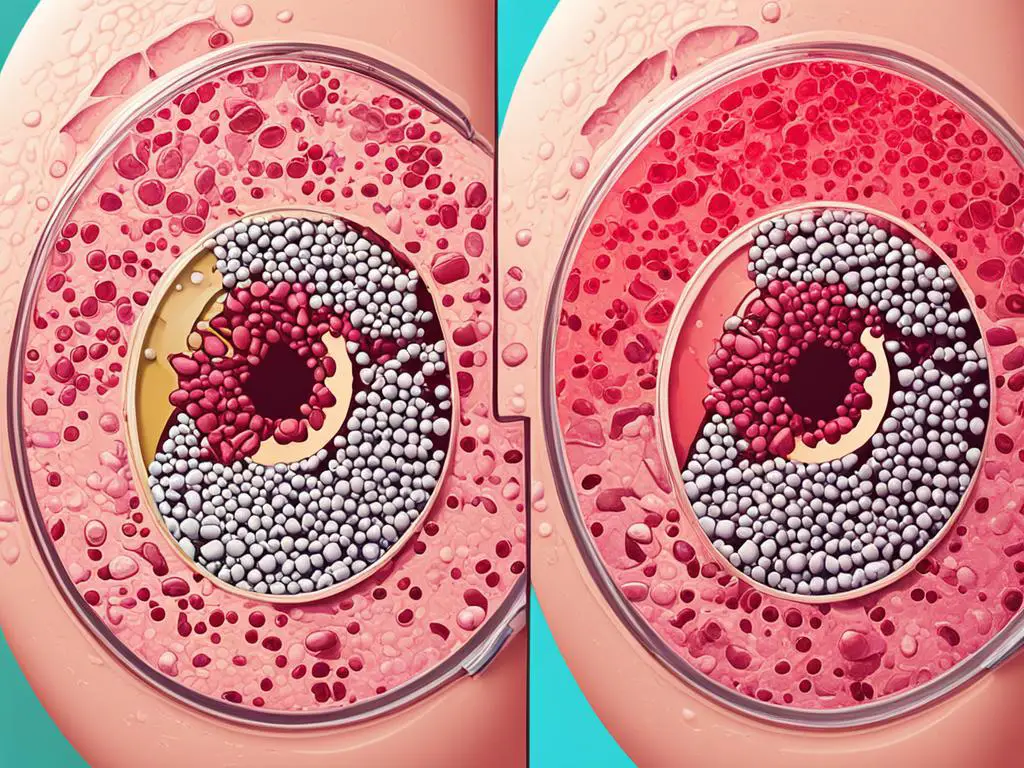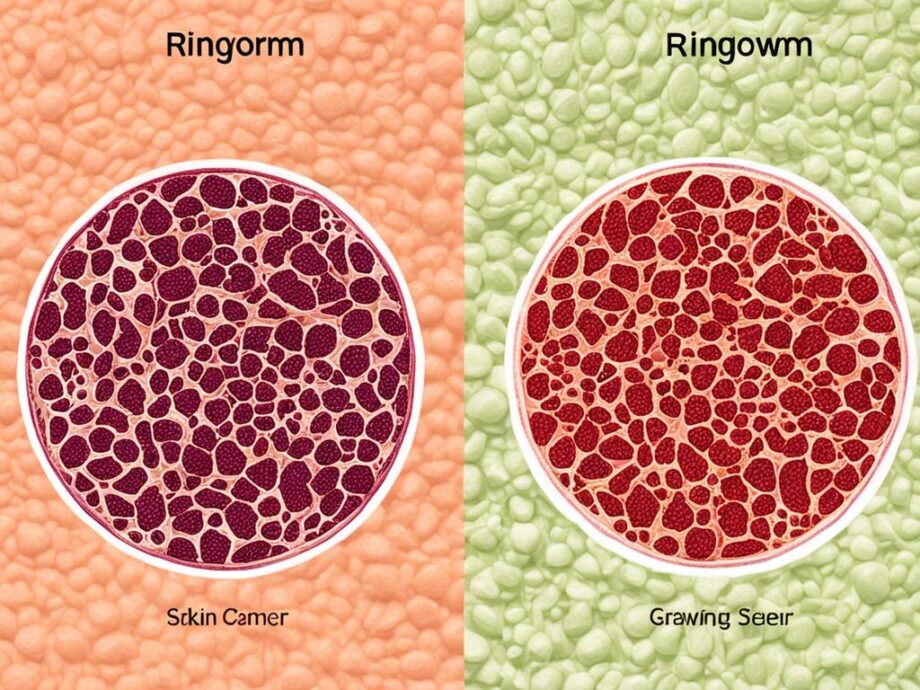In this article, we will explore the key differences between ringworm and skin cancer to help you accurately identify your skin concern. It’s important to understand the distinctions between these two conditions in order to seek appropriate treatment.
Key Takeaways:
- Ringworm and skin cancer are different skin conditions that require separate treatment approaches.
- Ringworm is a fungal infection characterized by a circular, itchy rash, while skin cancer involves the abnormal growth of skin cells.
- If you are unsure about your skin condition, consult a dermatologist for a professional evaluation.
- Treatment for ringworm may include over-the-counter antifungal creams, while skin cancer treatment depends on the type, stage, and location of the cancer.
- Early detection and timely treatment are vital for both ringworm and skin cancer.
What is Ringworm?
Ringworm, also known as dermatophytosis, is a common fungal infection that affects the skin. It is caused by a group of fungi called dermatophytes, which thrive in warm and moist environments.
Ringworm often manifests as a red, itchy, and circular rash, which can appear on various parts of the body. The characteristic circular shape is where it gets its name from. The infection can cause the affected area to become scaly and develop small blisters or pustules.
Understanding the symptoms and characteristics of ringworm is crucial for differentiating it from skin cancer. It’s important to note that ringworm is not caused by a worm, despite its misleading name.
| Ringworm | Skin Cancer |
|---|---|
| Caused by fungi called dermatophytes | Caused by abnormal growth of skin cells |
| Forms a circular rash | May present as irregular moles or growths |
| Red, itchy, and scaly | May be pink, red, or dark in color |
| Can appear on various body parts | May develop anywhere on the body |
| Treated with antifungal creams | Treatment varies depending on the type and stage |
If you suspect you have ringworm or skin cancer, it is important to consult a healthcare professional for an accurate diagnosis and appropriate treatment. Remember that self-diagnosis is not reliable and it is always best to seek medical advice.
Understanding Skin Cancer
Skin cancer is a serious condition characterized by the abnormal growth of skin cells. It is essential to be aware of the different types of skin cancer and the risk factors associated with it in order to differentiate it from ringworm. By understanding the various aspects of skin cancer, you can take proactive measures to protect your skin health.
Types of Skin Cancer
There are several types of skin cancer, each with its own characteristics and treatment options. The most common types include:
- Basal cell carcinoma: This type of skin cancer typically appears as a waxy bump or a flat, flesh-colored or brown scar-like lesion.
- Squamous cell carcinoma: Squamous cell carcinoma often manifests as a firm, red nodule or a scaly, crusted patch.
- Melanoma: Melanoma is the most aggressive type of skin cancer, and it can appear as a dark, irregularly shaped mole or a rapidly changing spot on the skin.
Risk Factors
Several risk factors increase the likelihood of developing skin cancer. These include:
- Prolonged sun exposure: Spending long hours in the sun, especially without protection, increases the risk of skin cancer.
- History of sunburns: A history of severe sunburns, particularly during childhood or adolescence, raises the risk.
- Fair skin: People with lighter skin tones have less melanin, which provides natural protection against harmful UV rays and increases their vulnerability to skin cancer.
- Family history: Having family members who have had skin cancer can be an inherited risk factor.
Being aware of these risk factors can help you take preventative measures and seek early detection for skin cancer. Regular self-examinations and professional screenings are crucial for maintaining skin health.

| Type of Skin Cancer | Characteristics |
|---|---|
| Basal Cell Carcinoma | Waxy bump or flat, flesh-colored or brown scar-like lesion |
| Squamous Cell Carcinoma | Firm, red nodule or scaly, crusted patch |
| Melanoma | Dark, irregularly shaped mole or rapidly changing spot on the skin |
Differentiating Symptoms
While ringworm and skin cancer may share some overlapping symptoms, there are specific indications that can help differentiate between the two. Understanding these differences in symptoms is essential for accurate self-diagnosis.
Ringworm Symptoms
Ringworm typically presents as a red, scaly, and itchy rash with a distinct circular shape. The affected area may have raised edges and clear in the center, resembling a ring or worm, from which the name originates. The rash can appear on various parts of the body, including the scalp, hands, feet, and groin.
Skin Cancer Symptoms
Skin cancer may exhibit irregularly shaped moles or growths that can be pink, red, or dark in color. These moles or growths may change in size, shape, or texture over time. They may also bleed, ooze, or develop a crust. Skin cancer can occur anywhere on the body, but it is most commonly found on areas exposed to the sun, such as the face, neck, arms, and legs.
It’s important to note that these symptoms are general indications, and a proper diagnosis can only be made by a dermatologist or medical professional.
| Ringworm | Skin Cancer |
|---|---|
| Red, scaly, and itchy rash | Irregularly shaped moles or growths |
| Distinct circular shape | Pink, red, or dark in color |
| Affected area has raised edges and clear in the center | May change in size, shape, or texture over time |
By recognizing these different symptoms, you can better assess whether your skin concern may be ringworm or skin cancer. However, self-diagnosis should never replace professional medical advice. If you suspect you have either condition, it is crucial to seek guidance from a dermatologist or healthcare provider for an accurate diagnosis and appropriate treatment.
Seeking Medical Advice
If you are experiencing skin concerns and unsure whether it is ringworm or skin cancer, it is crucial to seek medical advice from a dermatologist. Consulting a professional will provide you with a thorough evaluation and accurate diagnosis, leading to appropriate treatment.
A dermatologist specializes in the diagnosis and treatment of skin conditions. They have the expertise to identify the specific characteristics of your skin concern and differentiate between ringworm and skin cancer.
During your consultation, the dermatologist will conduct a comprehensive examination of your skin, taking into consideration any symptoms, medical history, and risk factors. If necessary, they may recommend a skin biopsy to confirm the exact nature of the condition.
A skin biopsy is a medical procedure in which a small sample of skin tissue is taken for further analysis. It helps to determine whether the abnormality is caused by ringworm or skin cancer. The biopsy can be performed under local anesthesia and is a safe and relatively simple procedure.
Seeking medical advice is essential for accurate diagnosis and appropriate treatment. It allows you to receive personalized care and guidance from a medical professional, ensuring the best possible outcome for your skin health.
Why Consult a Dermatologist?
A dermatologist is a skin specialist who possesses the knowledge and expertise to diagnose and treat various skin conditions. Consulting a dermatologist for your skin concerns ensures that you receive specialized care and access to the latest advancements in dermatology.
Here are a few reasons why you should seek medical advice from a dermatologist:
- Accurate Diagnosis: Dermatologists are trained to identify the subtle differences between skin conditions and accurately diagnose the specific problem.
- Specialized Treatment: A dermatologist can provide personalized treatment plans tailored to your specific condition, ensuring optimal results.
- Preventive Care: Regular visits to a dermatologist can help detect potential skin issues early and prevent them from developing into more serious conditions.
- Expert Advice: Dermatologists can offer valuable advice on skincare routines, lifestyle changes, and preventive measures to maintain healthy skin.
Whether you suspect you have ringworm or skin cancer, consulting a dermatologist is essential for proper evaluation and guidance throughout your skincare journey.

When to Seek Medical Advice
If you notice any unusual changes in your skin, it is important to seek medical advice promptly. Some signs that indicate the need for a dermatologist consultation include:
- Development of new moles or growths on your skin
- Moles or growths that have changed in size, shape, or color
- Itchy, red, or scaly patches that do not heal
- Persistent rashes or skin lesions
- Wounds that do not heal or seem to be getting worse
Remember, early detection and intervention can significantly impact treatment outcomes. If you have any concerns about your skin, do not hesitate to schedule an appointment with a dermatologist.
Treatment Approaches
The treatment for ringworm and skin cancer varies significantly. Proper understanding of the different treatment approaches for these two conditions is vital for successful management.
Treating Ringworm
Ringworm, being a fungal infection, can often be effectively treated with over-the-counter antifungal creams. These creams typically contain active ingredients such as terbinafine or clotrimazole, which help eliminate the fungal infection. It is important to carefully follow the instructions provided with the cream and continue the treatment for the recommended duration, even after the symptoms have subsided. This helps prevent the recurrence of the infection. In severe or recurring cases, a dermatologist may prescribe stronger antifungal medications, such as oral antifungal tablets or prescription-strength creams.
Treating Skin Cancer
The treatment for skin cancer depends on various factors, including the type, stage, and location of the cancer. The chosen treatment approach aims to remove or destroy the cancer cells while minimizing damage to the surrounding healthy tissue.
1. Surgical Excision: Surgery involves the removal of the cancerous tissue along with a margin of healthy tissue. It is a common treatment option for localized skin cancers, such as basal cell carcinoma and squamous cell carcinoma.
2. Radiation Therapy: In certain cases, radiation therapy may be recommended to target and destroy cancer cells. It can be used as the primary treatment or in combination with surgery.
3. Chemotherapy: Chemotherapy uses powerful drugs to kill cancer cells. It is typically reserved for advanced or metastatic skin cancers, such as melanoma.
4. Targeted Therapy: Targeted therapy involves the use of drugs that specifically target certain molecules or pathways involved in skin cancer growth. This approach is often used for advanced melanoma.

Each treatment approach has its own potential side effects and considerations. The specific treatment plan is determined through a thorough evaluation and discussion between the patient and their healthcare team.
In the next section, we will conclude our article by summarizing the key differences between ringworm and skin cancer and highlighting the importance of seeking professional medical advice for an accurate diagnosis and appropriate treatment.
Conclusion
In conclusion, it is crucial to distinguish between ringworm and skin cancer to ensure accurate diagnosis and appropriate treatment. Ringworm, a common fungal infection, is characterized by a circular rash accompanied by itching and redness. On the other hand, skin cancer involves the abnormal growth of skin cells, often presenting as irregular moles or growths that may vary in color.
If you are unsure about your skin condition and suspect you may have either ringworm or skin cancer, it is always advisable to seek professional medical advice. Consulting a dermatologist will allow for a thorough evaluation, potentially involving a skin biopsy to confirm the diagnosis. Seeking medical advice is key to receiving the necessary treatment and preventing any potential complications.
Remember, self-diagnosis can be misleading, and it is important to rely on the expertise of healthcare professionals. By promptly consulting with a dermatologist, you can alleviate any concerns and address the condition effectively. Remember, early detection and appropriate treatment significantly increase the chances of successful management and recovery.
